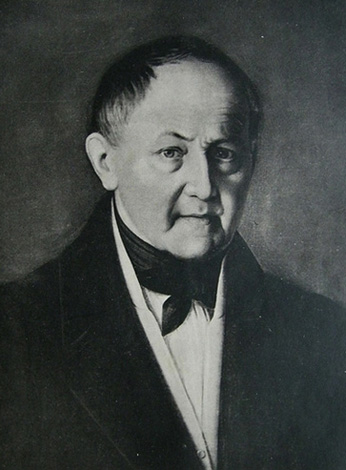Tymkivsky, Illia
Tymkivsky, Illia aka, in Russified form, Tymkovsky [Тимківський, Ілля; Tymkivs'kyj; Тимковський; Tymkovs'kyj], b 15 July 1773 in Pereiaslav, Pereiaslav regiment, d 15 February 1853 in Turanivka, Hlukhiv county, Chernihiv gubernia. Educator and scholar; descendant of the Cossack starshyna Tymkovsky family. Educated at the Kyivan Mohyla Academy (1784–89) and at Moscow University (where he studied philosophy and law in 1789–97), he began his career as a teacher of law and a civil servant in the Ministry of Justice in Saint Petersburg. Appointed head trustee of Kharkiv school district in 1803, he contributed to the creation of several gymnasiums in the region (namely, in Kharkiv, Chernihiv, Katerynoslav, Voronezh, Novhorod-Siverskyi, and Odesa) and to the establishment of Kharkiv University (opened in 1805). Professor at the latter instutition, he taught there until 1811 a number of disciplines, including law, history, and letters. Later he also served as a judge in Hlukhiv (1818 to 1821) and as director of the Novhorod-Siverskyi Gymnasium (1825–38). His memoirs—covering a period from his early childhood in Pereiaslav to 1797, when he already had moved to Saint Petersburg—appeared in the Moscow-based magazine Moskvitianin (1852, nos. 17, 18, and 20) under the title Moio opredelenie v sluzhbu (My Joining the Service).
Tymkivsky’s major scholarly work is his Opytnyi sposob k filosoficheskomu poznaniju Rossijskogo jazyka (Experiential Method Leading to a Philosophical Comprehension of the Russian Language), published in 1811 by Kharkiv University. Written on the whole in the tradition of the French general grammarians of the 18th century, this manual stands out by a rare richness of examples, meant to induce the reader to independently form an idea of the essential nature of human language as such and of Slavo-Russian in particular. Tymkivsky considered the language variety described in his textbook as a written ‘purified’ language of the entire nation, which arose from a fusion of its three most potent dialects, namely, those of Novgorod, Kyiv, and Moscow, and further elaborated through common usage following the changes and evolution of the social order. This integration process was termed by him ‘the inner formation’ as opposed to the ‘external impact’ coming from other languages (in the case of Slavic language these sources of external influence included Gothic, Finnic, Roxolan, Tatar, as well as modern European languages) and resulting in dialectal differentiation. In his analysis of similarities and dissimilarities between languages, Tymkivsky combined broad generalizations (drawing attention to affinities between Slavic, Sarmatian, Venedian, and Medean as their common source, as well as between Slavic and Sanskrit and between Slavic and Celtic) with some minute observations, such as the difference he noted (in his memoirs) between the dialect of Kyiv and that of his native Pereiaslav, where the original o was pronounced as a very clean and soft i: moj → mij (my), svoj → svij (one’s own), on → vin (he), ol'kha → vil'kha (alder tree), kon' → kin' (horse), pojdet → pijde (he/she/it will go) (dating back this feature to the times of Prince Volodymyr Monomakh). He based his study on the principle that ‘language is one of the patrimonial features of every people. The causes effective in the character and in the changes of both of them are so common that the History of a people comprehends the History of its language’.
Tymkivsky put forth a periodization of Slavo-Russian written tradition, dividing it into five stages: 1) first translations of the Church books; 2) original writings from the princely Kyiv, including the chronicles, the Slovo o polku Ihorevi and other texts; 3) later chronicles mostly of Northern Russian, but also of Volhynian origin, as well as princely documents of the time; 4) various texts from mid-17th to early 18th century, including official documents, theological, philosophical, rhetorical and poetic works by authors such as Teofan Prokopovych and Simeon Polotsky, the satires by Antiokh Kantemir, etc.; and 5) the philologically pure style introduced by Vasilii Trediakovsky, Mikhail Lomonosov, and Aleksadr Sumarokov.
One of the innovative aspects of Tymkivsky’s practical description of Slavo-Russian was his treatment of the problem of word order in this language. He distinguished between: 1) necessary, or logical, and 2) arbitrary that was, in turn, divided into rhetorical and poetical.
Tymkivsky also left an unfinished manuscript in Russian entitled Zapiski dlia istorii Malorossii (Notes on the History of Little Russia), on which he worked from 1849 on.
Although Tymkivsky’s scholarly output remained relatively little-known for a long time (despite his name being mentioned among those to whom the new discipline of linguistics ‘owes its scientific development and its most brilliant results’ in the 1873 edition of the French Grand Dictionnaire Universel du XIXe siècle by Pierre Larousse), he exerted a considerable impact on some intellectuals on a personal level, influencing, among others, his nephew Mykhailo Maksymovych, the famous writer and scholar Panteleimon Kulish, the literary scholar and educator Mykhailo Chaly, and the renowned specialist in pedagogy Konstantin Ushinsky (the latter three were his pupils in the Novhorod-Siverskyi Gymnasium).
BIBLIOGRAPHY
Shugurov, Nikolai. ‘Il'ia Fedorovich Timkovskij, pedagog proshlogo vremeni,’ KS, nos. 8–10 (1891)
Bulich, Siergiei. Ocherk istorii iazykoznaniia v Rossii. Vol 1 (XIII v. – 1825 g.) (Saint Petersburg 1904)
Ananieva, Tatiana. ‘Mezhdu “skazaniem” i “episodes en swift”: o neizvestnoi rukopisi Ilii Timkovskogo “Zapiski dlia istorii Malorossii” (1849 g.),’ Kyïvs'ka Akademiіa, vyp. 15 (2018)
Malenko Olena; Borysov, Volodymyr. Ukraïns'ke movoznavstvo iak naukovyi dyskurs: istoriia, teoriia, praktyka (Kharkiv 2021)
Serhii Vakulenko
[This article was updated in 2022.]
